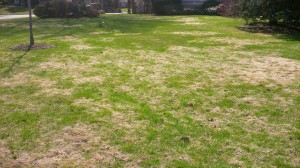Have you ever wondered why some sections of the lawn are slow to green up and take longer to come out of dormancy during the spring? Creeping bentgrass is notorious for greening up slowly, especially compared with Kentucky Bluegrass and Perennial Ryegrass. As a result, sporadic sections of the lawn remain dormant and straw coloured until the creeping bentgrass catches up with the other grass species that were quick to green up. This can sometimes take several weeks before the creeping bentgrass finally does catch up.
Creeping bentgrass is typically considered undesirable in home lawns and unfortunately more often than not we have to live with it, not without it. Under regular home lawn maintenance conditions creeping bentgrass does not perform well. Its aggressive stoloniferous growth habit makes it very difficult to maintain at regular mowing heights of 2.5” – 3”. As well, it chokes out and invades other desired species making it challenging to keep under wraps and from spreading across the lawn. To make matters worse, there is a distinct colour difference with its lighter pale green colour, making it stand out against the rest of the darker emerald green Kentucky bluegrass and Perennial ryegrass.
As an alternative approach to speeding up the green up process for the future spring seasons, introducing several cultural practices such as Core aeration, overseeding, topdressing, and slitseeding will promote the establishment of more desired turf species in these areas.





